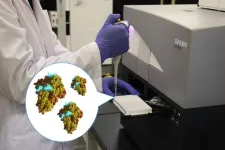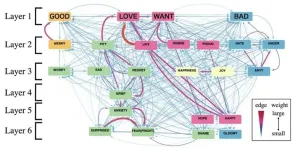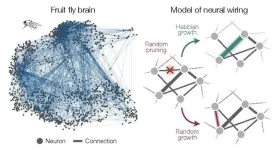Glowing COVID-19 diagnostic test prototype produces results in one minute
2024-01-17
(Press-News.org) Cold, flu and COVID-19 season brings that now-familiar ritual: swab, wait, look at the result. But what if, instead of taking 15 minutes or more, a test could quickly determine whether you have COVID-19 with a glowing chemical? Now, in ACS Central Science, researchers describe a potential COVID-19 test inspired by bioluminescence. Using a molecule found in crustaceans, they have developed a rapid approach that detects SARS-CoV-2 protein comparably to one used in vaccine research.
From fireflies to lantern fish, many animals possess the chemical tools to produce light. Typically, this reaction requires the substrate luciferin and the enzyme luciferase. However, a class of less discriminating luciferins, known as imidazopyrazinone-type (IPT) compounds, can glow when encountering other proteins, including ones that aren’t considered enzymes. Previous research suggests that IPT luciferins could serve as the basis for a new type of medical test that uses luminescence to announce the presence of a target protein in a specimen. Ryo Nishihara, Ryoji Kurita and colleagues suspected that an IPT luciferin could react with the SARS-CoV-2 spike protein, which allows the virus particles to invade cells and cause COVID-19 ― and open the door to develop a glowing test.
The team first investigated 36 different IPT luciferins’ abilities to react with a single unit of spike protein. Only one molecule, which came from tiny crustaceans from the genus Cypridina, emitted light. The researchers then tested the luciferin’s activity with the spike protein in its natural state, as three units folded together. They found that, over the course of 10 minutes, an adequate amount of light could be detected. A commercially available luminescence reading device was required; the light could not be seen by the naked eye. Additional experiments indicated that the IPT luciferin was selective because it did not glow when exposed to six proteins that occur in saliva. They define this specific luminescence reaction by non-luciferase biomolecules as “biomolecule-catalyzing chemiluminescence (BCL)”.
Finally, they found that the luciferin could detect the amount of the spike protein in saliva with the same accuracy as a technique currently used in vaccine development. However, the luciferin system delivered results in one minute — significantly faster than the current rapid point-of-care tests.
This BCL-based approach could serve as the basis for a simple “mix and read” test in which the IPT luciferin is added to untreated saliva from someone suspected of having COVID-19, according to the researchers. They note that a similar approach could be adapted to detect other viruses that possess spike-like proteins, such as influenza, MERS-CoV and other coronaviruses.
The authors acknowledge funding from the Japan Science and Technology Agency, the Japan Society for the Promotion of Science, and the New Energy and Industrial Technology Development Organization.
The paper’s abstract will be available on Jan. 17 at 8 a.m. Eastern time here: http://pubs.acs.org/doi/abs/10.1021/acscentsci.3c00887
###
The American Chemical Society (ACS) is a nonprofit organization chartered by the U.S. Congress. ACS’ mission is to advance the broader chemistry enterprise and its practitioners for the benefit of Earth and all its people. The Society is a global leader in promoting excellence in science education and providing access to chemistry-related information and research through its multiple research solutions, peer-reviewed journals, scientific conferences, eBooks and weekly news periodical Chemical & Engineering News. ACS journals are among the most cited, most trusted and most read within the scientific literature; however, ACS itself does not conduct chemical research. As a leader in scientific information solutions, its CAS division partners with global innovators to accelerate breakthroughs by curating, connecting and analyzing the world’s scientific knowledge. ACS’ main offices are in Washington, D.C., and Columbus, Ohio.
To automatically receive news releases from the American Chemical Society, contact newsroom@acs.org.
Note: ACS does not conduct research, but publishes and publicizes peer-reviewed scientific studies.
Follow us: Twitter | Facebook | LinkedIn | Instagram
END
ELSE PRESS RELEASES FROM THIS DATE:
2024-01-17
Though natural fertilizers made from treated sewage sludge are used to reintroduce nutrients onto agricultural fields, they bring along microplastic pollutants too. And according to a small-scale study published in ACS’ Environmental Science & Technology Letters, more plastic particles get picked up by the wind than once thought. Researchers have discovered that the microplastics are released from fields more easily than similarly sized dust particles, becoming airborne from even a slight breeze.
Microplastics, or small bits of plastic less than 5 millimeters long, have appeared everywhere from clouds to heart tissues. And with these plastics’ increasing prevalence in ...
2024-01-17
LOS ALAMOS, N.M., Jan. 17, 2024 — New insights from artificial intelligence about permafrost coverage in the Arctic may soon give policy makers and land managers the high-resolution view they need to predict climate-change-driven threats to infrastructure such as oil pipelines, roads and national security facilities.
“The Arctic is warming four times faster than the rest of the globe, and permafrost is a component of the Arctic that’s changing really rapidly,” said Evan Thaler, a Chick Keller Postdoctoral Fellow at Los Alamos National Laboratory. Thaler is corresponding ...
2024-01-17
Emotions exert a profound influence on human behavior, prompting extensive explorations in the realms of psychology and linguistics. Understanding central emotions also has practical utility since it can help organizations create messages that resonate better with people. For instance, businesses can enhance their connection with their customers, and non-profits can prompt quicker action by skillfully leveraging the salient emotions in humans.
Colexification is a phenomenon in which the occurrence of a single word is associated with multiple concepts that share semantic relationships. The analysis of colexification is an innovative linguistic method for ...
2024-01-17
Research Highlights:
Consistently high scores of perceived stress during adolescence through adulthood may contribute to worse cardiometabolic health including obesity in young adults..
Researchers suggest the adoption of healthy coping strategies for stress management early in life may help prevent cardiometabolic diseases, from heart disease to Type 2 diabetes.
Embargoed until 4 a.m. CT/5 a.m. ET Wednesday, January 17, 2024
DALLAS, January 17, 2024 — Young adults who reported higher stress during their teenage years to adulthood were more likely to ...
2024-01-17
Over the last decades, air pollution emissions have decreased substantially; however, the magnitude of the change varies by demographics, according to a new study by Columbia University Mailman School of Public Health. The results indicate there are racial/ethnic and socioeconomic disparities in air pollution emissions reductions, particularly in the industry and energy generation sectors. The findings are published in the journal Nature Communications.
The research provides a national investigation of air pollution emission ...
2024-01-17
New York, January 17, 2024 — In all species, brain function relies on an intricate network of connections that allows neurons to send information back and forth between one another, commanding thought and physical activity. But within those networks a small number of neurons share much stronger connections to one another than all the others. These abnormally strong connections—known as “heavy tailed” based on the shape of their distribution—are thought to play an outsized role in brain function.
Researchers ...
2024-01-17
A new study by physicists and neuroscientists from the University of Chicago, Harvard and Yale describes how connectivity among neurons comes about through general principles of networking and self-organization, rather than the biological features of an individual organism.
The research, published on January 17, 2024 in Nature Physics, accurately describes neuronal connectivity in a variety of model organisms and could apply to non-biological networks like social interactions as well.
“When you’re building simple models to ...
2024-01-17
Sensors built with a new manufacturing approach are capable of recording activity deep within the brain from large populations of individual neurons–with a resolution of as few as one or two neurons–in humans as well as a range of animal models, according to a study published in the Jan. 17, 2024 issue of the journal Nature Communications. The research team is led by the Integrated Electronics and Biointerfaces Laboratory (IEBL) at the University of California San Diego.
The approach is unique in several ways. It relies on ultra-thin, flexible and customizable probes, made of clinical-grade materials, and equipped with sensors that can record extremely localized ...
2024-01-17
Large-scale genetic analysis has helped researchers uncover the interplay between cancer-driving genetic mutations and inherited genetic variants in a rare type of blood cancer.
Researchers from the Wellcome Sanger Institute, the University of Cambridge, and collaborators, combined various comprehensive data sets to understand the impact of both cancer-driving spontaneous mutations and inherited genetic variation on the risk of developing myeloproliferative neoplasms (MPN).
The study, published today (17 January) in Nature Genetics, describes how inherited genetic variants can influence whether a spontaneous mutation in a particular ...
2024-01-17
When a person has one or more blocked arteries, providers may choose to conduct a minimally invasive procedure known as percutaneous coronary intervention, or PCI.
By inflating a balloon and potentially placing a stent, blood can flow more freely from the heart.
Despite carrying less risk than open surgery, stenting and balloon angioplasty can result in complications like bleeding and kidney injury.
Researchers at Michigan Medicine developed an AI-driven algorithm that accurately predicts death and complications after PCI — which could emerge as a tool ...
LAST 30 PRESS RELEASES:
[Press-News.org] Glowing COVID-19 diagnostic test prototype produces results in one minute






